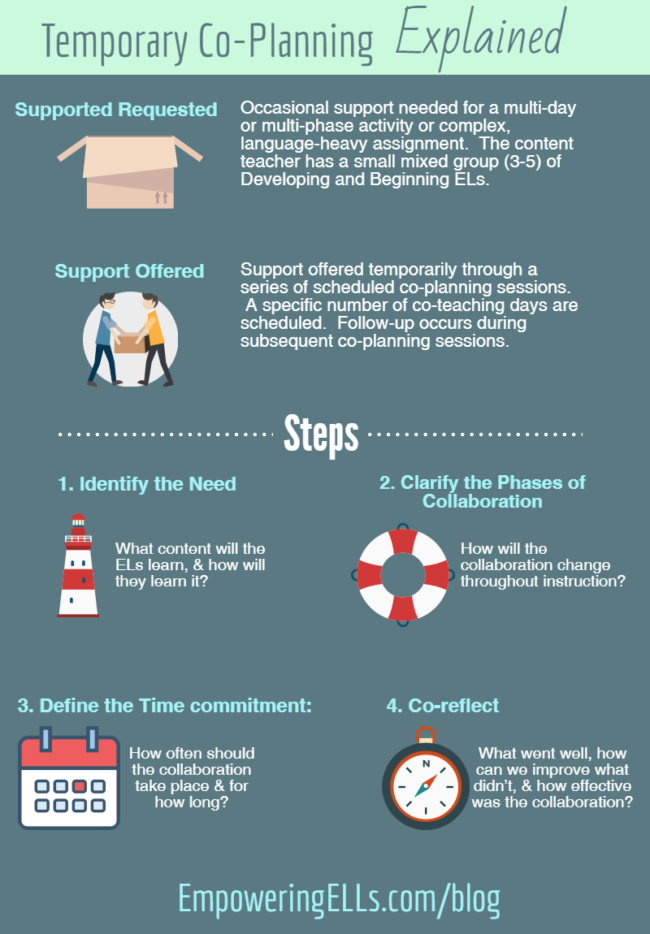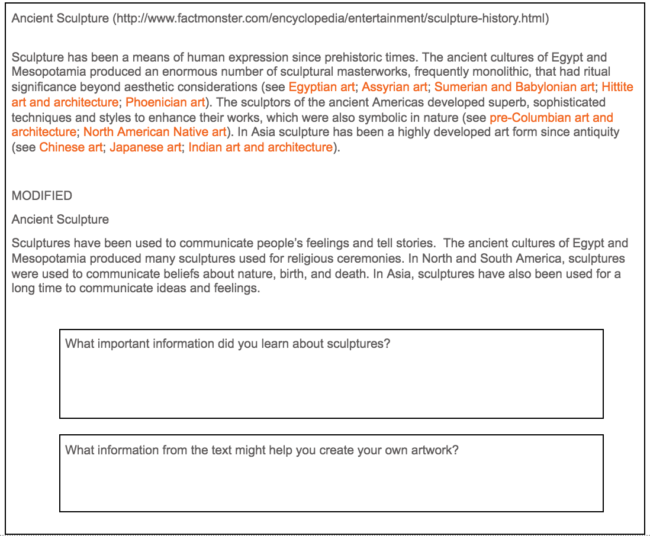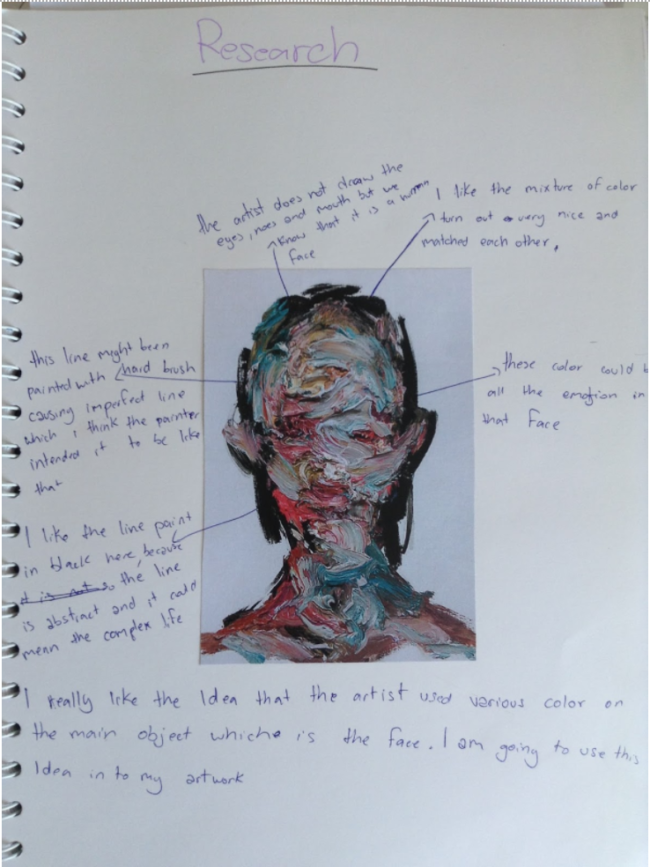In the previous article, I shared two philosophies that foster positive, collaborative relationships with colleagues. While they are particularly relevant for Informal Co-Planning, they are also applicable to any form of co-planning. Once content teachers feel respected by the English language teacher (ELT), they’re more likely to seek support for bigger, more specific tasks.
The next phase of co-planning is One-Off Co-Planning, which is a need-based request for consultation. Conveniently, I have already written a post describing this phase in an article entitled One-Off Co-Planning: How To Win Friends and Collaborate with Content Teachers.
Instead of writing more articles on One-Offs, I recommend going to the “Categories” section on the right side of the blog and click on “Teacher Collaboration”. It will lead you to all the articles related to co-planning, most of which are case studies of One-Off co-planning.
So now – we’ll skip forward to the third level of the Collaboration Continuum: Temporary Co-Planning.
What is Temporary Co-Planning?
There are times when teachers need to work together beyond a quick conversation in the hallway but don’t require ongoing, year-long co-planning and co-teaching. This type of need is called Temporary Co-Planning.
The purpose of Temporary Co-Planning is to provide support that empowers the content teacher to work independently after the co-planning has ended. It works best in a defined period of time such as a unit of learning or when a teacher is seeking professional development.
This form of co-planning lasts more than one day because more time is required to map standards, create assessments, design learning experiences, and produce scaffolds. It works best for a small, mixed group of Developing and Beginning ELs (about 3-5 students total).
Elements of Temporary Co-Planning
There are four steps of Temporary Co-Planning:
- Identify the Need
- Define the Time Commitment
- Clarify the Phases of Co-Planning
- Co-Reflect on the Result
Because Temporary Co-Planning is focused primarily on raising ELs’ access to content and facilitating their’ engagement in learning experiences, ELs don’t receive explicit instruction on developing their academic language. The latter is the defining feature of Sustained Co-Planning, which I’ll write about next week.
The case study below illustrates how these steps of Temporary Co-Planning were realized in one art classroom in particular.
Case Study: Art
Steps 1 & 2: Identify the Need & Define the Time Commitment
These first two steps are married together. The ELT has to find out what the content teacher needs, which determines the time commitment required.
Ms. N, an art teacher, came and asked if I could help make her unit more EL-friendly. During our initial discussion, she explained that the International Baccalaureate Program’s approach to visual arts education involves quite a bit of literacy. Not being a language instructor and feeling uncomfortable with co-teaching, she asked for easy ways to implement EL-appropriate strategies in her lesson plans.
Ms. N wanted me to meet once a week during the 5-week unit to provide feedback on her implementation of the strategies. Because the nature of her request, I determined that Temporary Co-Planning would be the most appropriate strategy for her needs.
Ms. N mentioned that students would have to use language in two ways:
- To read academic texts to build their background knowledge of a particular form of art, and
- To apply the research while creating their own pieces.
I recommended that she chunk the reading experience so that there would be time for synthesizing the text. Chunking involves segmenting the text into manageable sections and pasted them onto their own page. On each page, we created a textbox that asked the ELs how they planned to incorporate this information into a future piece of art.
Essentially, we created a graphic organizer to scaffold their reading. I also recommended modifying the text for the Developing ELs in her class. It looked like this:
Ms. N asked me to come back the following week to talk about how she applied the strategy. When I returned, I had only praise for her implementation, and we followed-up on how the ELs were using the scaffold.
Ms. N said that it was helpful for many of them because the textual scaffold built in time for the ELs to pause and think. This process is called Visible Reading, which teaches ELs to interact with the texts like proficient readers do. She also added that reading their responses provided formative data which helped guide her instruction.
Step 3: Clarify the Phases of Collaboration
This step means for you to discuss with the content teacher how your collaboration will change over time. As students progress throughout the unit, the collaboration should change focus accordingly.
Ms. N wanted our consultations to be about either accessing the text or producing writing. Once we figured out a reading scaffold, we transitioned our conversations to focus on helping ELs write about art. Ms. M wanted students to plan their artwork in their art journals before actually creating it.
While the ELs didn’t need to write a whole essay, they still had to communicate their plans in writing in some way. I saw a fantastic opportunity to have students Quick Write. Because the students had already analyzed a specific form of art, we had them write a paragraph for each aspect of that art form. This form of scaffolding (seen below) is a kind of extended text annotation:
Finally, students were to reflect on their artwork and the process of creating it. Again, Ms. N did not need an entire essay, but there were specific things that she wanted her ELs to communicate in writing. We decided that an interactive table would be a helpful scaffold. Ms. N identified the things that she wanted the students to respond to, and I created a table to house these questions. She then had students paste the interactive table into their art journals and answer the questions there.
Step 4: Co-Reflect on the Result
After Ms. N finished the unit, we had another quick conversation to reflect on our temporary co-planning. We
- looked at students’ work,
- talked about the effectiveness of the scaffolds, and
- discussed how she might use them in the future.
I also took the opportunity to recognize Ms. N’s incredible sense of responsibility for her ELs and her willingness to try new approaches. She sought to collaborate without being asked to by an administrator (which happens very rarely).
We both felt that she was now better able to support her ELs in art class, so we decided to not co-plan on the next unit. However, even though no more formal meetings were needed after this Temporary Co-Planning, she continued to email me her reading scaffolds and interactive tables because she wanted the language to be EL-friendly.
Takeaways
Temporary Co-Planning is a fantastic opportunity for ELTs to share strategies and raise awareness of the importance of scaffolding for literacy across disciplines. It helps turn the phrase “Everyone is a language teacher” from a dream to a reality.
Effective Temporary Co-Planning is like forming great connections on the first date. Good dates lead to more outings and adventures because you’ve earned their trust and made them comfortable interacting with you. So put on your nice suit and enjoy the company!
Next Post
In next week’s article, we’ll dive into Sustained Co-Planning – the most dynamic form of collaboration – whose ongoing nature provides for real gains and the development of a synergistic relationship. Because Sustained Co-Planning is so extensive, I’ll be sharing just the co-planning aspect of it in the next few articles.
How often are you able to engage in Temporary Co-planning? What do you like about it? Let me know in the comments below.




